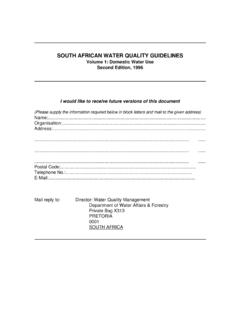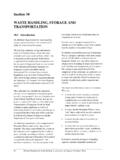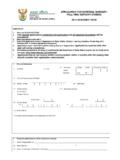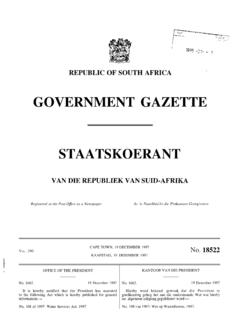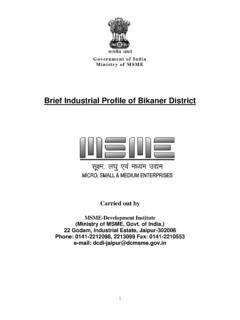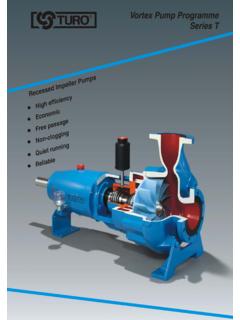Transcription of Sustainable wastewater treatment – what has gone …
1 Sustainable wastewater treatment what has gone wrong and how do we get back on track?Heidi G. SnymanAM van NiekerkN RajasakranOverview of the wastewater treatment industry in SA Most WWTPs in SA are relatively small systems< Ml/day50% - 2 Ml/day11%2 - 10 Ml/day21%10 - 25 Ml/day10%> 25 Ml/day7%No. of Plants: 986 Introduction Metros typically have a few large WWTPs and are generally well equipped and operated Specific challenges exist for smaller and poorer communities The challenges relate to the small scale of operation and having to establish new skills and competencies The infrastructural, mechanical and electrical maintenance of the plants also present challengesNational survey 51 plants in eight Provinces.
2 Micro plants (< 500 m3/day); small plants (500 2 000 m3/day); medium plants (2 000 10 000 m3/day) plant The technology utilized, resources deployed for operations and maintenance and overall performance was assessed at each of plants included in the surveyGeneric evaluation protocolCapital infrastructureHuman resourcesFinancial resourcesInformation resourcesFlow and loadsUnit process performanceEffluent qualitySludge handlingEnvironmentalLegalSocio-economic HealthResources deployedPlant performanceStakeholder requirementsResources deployed on wastewater treatment plants7591511201992518181836140242413500 0200000%10%20%30%40%50%60%70%80%90%100%C apital infrastructureHuman resources (Operational)
3 Human resources (Maintenance)Financial resourcesInformation resourcesMajor intervention requiredIntervention requiredAdequateIdeal situationOver resourcedSignificantly over resourcedResources deployed The data shows that some form of intervention is required with regards to the following: Capital infrastructure investment is required at 35 % of the plants Additional skilled operational staff is required to operate the plant efficiently at 50 % of the plants Additional skilled maintenance staff is required to adequately maintain the installed mechanical/electrical equipment and instrumentation at 56 % of the plants Supplemental financial resources are required to support the routine operation and maintenance at 21 % of the plants Additional information resources are required to properly operate the facilities at 63 % of the plantsResources deployed on wastewater treatment plants The
4 Need for additional or upgraded plant infrastructure or the need for additional funding is not the root cause of the poor performance at the majority of surveyed plants The most pressing need is the critical shortage of trained, skilled and experienced process controllers and mechanical/electrical maintenance staff Most plants operate with insufficient information to guide optimised operations, but this shortcoming can be partially overcome by trained and skilled process controllersPlant wastewater flow and loads 16 % are hydraulically overloaded 22 % are overloaded in terms of the organic/nutrient load >35 % of the plants can accommodate higher flows and loads depend on the capacity of the operators to operate a plant that is running close to or at design capacity22692021321817200%10%20%30%40%50 %60%70%80%90%100%Flow receiv edLoad receivedMajor intervention requiredIntervention requiredAdequateIdeal situationOver resourcedSignificantly over resourcedTreatment Process Performance More than
5 Half the plants experience problems with the following unit processes: Flow balancing facility is not available on the majority of surveyed plants. Secondary treatment Including oxidation pond treatment , trickling filters and activated sludge which has different levels of complexity and mechanical/electrical component content Poor performance plants were almost equally represented in all the main secondary treatment process technologies The complexity of the treatment technology is not a major differentiating factor in plant performanceTreatment Process Performance Maturation ponds Many of the maturation ponds are filled with sludge and overgrown with reeds.
6 Many plants bypass the maturation ponds and do not understand the important polishing and disinfection function of maturation ponds. Chlorination 67 % of the plants that disinfect final effluent are experiencing operational problems. Problems include inadequate design of disinfection systems, inappropriate disinfection technology employed, inadequate operation and management of chlorine stock. Residue and sludge management 24 25 % of plants experience problems disposing of screenings and grit Most plants rely on the either the extended aeration or long resident time in pond systems. Most of the plants rely on solar drying in drying beds or sludge ponds/lagoons Although these are fairly simple processes.
7 Poor operational practices were observed at 39% of the plants Disinfection process for sludge is almost non- existing Inadequate disposal and use of sludge were recorded at 81% of the plants None of the plants visited would comply with the new SA Sludge GuidelinesMaintenance aspects Immediate intervention is required at 30 % of the plants Intervention required at > 60 % of the plants 10 % of plants are maintained to ensure Sustainable functionality128157111413222012122017169 19192613141453433250%10%20%30%40%50%60%7 0%80%90%100%Preventative maintenanceRoutine electrical maintenanceRoutine mechanical maintenanceRedundancyTurn around timeEquipment replacementAvailability of qualified staffMajor problemsProblematic AdequateIdeal situationEnvironmental Impacts and Regulatory Compliance The compounding effect of all the operational aspects evaluated as well as the general lack of maintenance.
8 15111927159210%10%20%30%40%50%60%70%80%9 0%100%Environmental and healthimpactAuthorization andcomplianceMajor problemsProblematic AdequateIdeal situationEnvironmental Impacts and Regulatory Compliance 30 % require immediate intervention to avoid crisis situations such as an outbreak of waterborne diseases In the short to medium term intervention would be required at more than 66 % of the plants The Department of Water Affairs and Forestry requires a 95 percentile compliance to the conditions stipulated in the authorisation. If these performance criteria are strictly enforced, only 4 % of the surveyed plants are adequately operated and of Operating Staff at South Africa wastewater treatment Plants Major intervention required and practically no trained and competent operations staff available to plant (10%) Intervention required with a limited number of trained and competent operations staff available to plant (40%) Plant adequately resourced in terms of operations staff but further training of staff required (36%) Staff properly trained, qualified and experienced to competently operate the treatment plant.
9 Ongoing training and education programmes are implemented (4%) Plant facility has more trained and qualified operational staff allocated to the entire operation of the plant than is required (10%)Framework for Intervention StrategiesSpheres of influenceUrgent / immediate actionsShort term actionsLong term actionsGovernance and regulatory aspects999 Facility management and ownership aspects999 Facility planning and construction aspects999 Operations and maintenance of facilities999 Key Components of Intervention Strategy Regulatory interaction with WWTP owners and operators. Institutional arrangements. Service delivery systems.
10 Advancement of appropriate treatment technology. Capacity of operations staff resources. Capacity of maintenance staff resources. Financial support programs. Information systems. Collaborative number of process controllers required to effectively operate the micro, small and medium wastewater treatment plants in South Africa Class operator Number of operators required Number of registered operators in the DWAF data baseShortfall of registered operators Trainee 838438400I 1136711065II 838153685 III 696 229 467 IV 29825444V
